Maungatautari
Maungatautari is a mountain, rural community and ecological area near Cambridge in the Waikato region in New Zealand's central North Island.
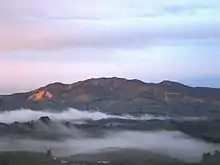
The New Zealand Ministry for Culture and Heritage gives a translation of "mountain of the upright stick" for Maungatautari.[1]
The Maungatautari Restoration Project is the largest ecological restoration project in New Zealand.
The project is engineered to remove all non-native pest mammals and predators and restore endangered native flora and fauna to Maungatautari. There is no intention to restrict all introduced birds, but efforts will be made to control exotic wasps. It includes private land and a government-owned scenic reserve administered by Waipa District Council. It is a community project managed by the Maungatautari Ecological Island Trust.
Maungatautari Marae and Te Manawanui meeting house located on the northern edge of the mountain, overlooking the Waikato River.[2] It is a meeting place for the Ngāti Korokī Kahukura hapū of Ngāti Hourua and Ngāti Ueroa,the Ngāti Raukawa hapū of Ngāti Korokī and Ngāti Mahuta and the Waikato Tainui hapū of Ngāti Korokī and Ngāti Raukawa ki Panehākua. It is the main marae for the, Taute, Kara, Tupaea, Wirihana, Poka and Tauroa whānau, among others.[3]
Waniwani Pā is also a traditional meeting ground for the Ngāti Korokī Kahukura hapū of Ngāti Waihoro.[2][3]
Ecological area
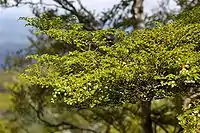
Maungatautari is an eroded andesitic volcano. It was chosen as a suitable site for the project for a number of reasons, including the diversity of its terrain, the relative integrity of natural areas in spite of some human engineered changes, the commitment of surrounding communities, and the feasibility of fence-construction given surrounding developed terrain.
Some elements of the diversity of Maungatautari took scientists by surprise. In April 2006, the discovery of 100 silver beech trees caused considerable excitement in the botanical community. The tree, native to southern New Zealand, had not previously been believed to be present on Maungatautari, although researchers who came to investigate emphasized that the tree had probably been established during the last ice age. The largest of the trees were estimated to be several centuries old. Jim Mylchreest, Maungatautari Trust's chief executive, pointed out that the trees were not only exciting in themselves, but also for the fungi and insects they might host that also may not have been expected to be present on Maungatautari.
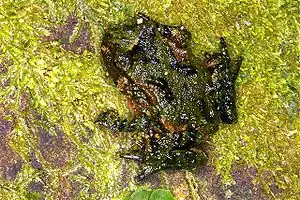
Species found
In December 2004, eleven endangered Hochstetter's frogs were found living on Maungatautari in a rocky region. There had already been discussions about potentially reintroducing the Hochstetter's frog to the preserve, and the rare discovery of the small population in an environment being prepared to protect them excites the scientific community.
A dead Duvaucel's gecko was found in a mouse trap in March 2010; this was the first sighting of this species on mainland New Zealand for almost 100 years, probably indicating a surviving population of the gecko within Maungatautari.[4]
Ecological restoration plan
Because poisons and trapping, traditional methods of pest control, have limited success and seldom last long, the creators of the plan decided to enclose the 34 square kilometres of bush with a 47 km pest-exclusion fence to create an ecological island. When the environment is rendered suitable, the area will be repopulated with the entire suite of charismatic species that may now be locally extinct, such as North Island brown kiwi, North Island kōkako, kakariki, tuatara and many others. Kaka already visit regularly and are likely to become resident if suitable methods are employed.
In November 2003, the Trust constructed two exclosures, at the north and south of Maungatautari, totalling 1.1 square kilometres. The Trust used these areas to demonstrate the fence's feasibility and to test pest removal methods, which were launched in September 2004. The exclosures are now predator-free and were used as holding areas for native species while the main fence was being built.
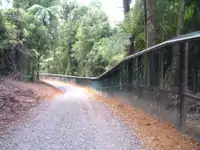
In July 2004, the Trust began constructing the Xcluder fence. In September 2006 the Trust completed fencing the entire 34 square kilometres to exclude all pests (and was able to take advantage of parts of the exclosures' fencing constructed at Stage 1). Then the Trust began eliminating pests by dropping poison, starting with brodifacoum in November 2006. A second application was made in December 2006. The combined effect of the poison, trapping and hunting eliminated brown rats, black rats, stoats, cats, weasels, ferrets, red deer, fallow deer, pigs, goats, possums, hedgehogs, rabbits and hares. In 2007 the sole remaining pest species was mice, and poison was dropped a third time, in September that year, to eradicate them. This failed, and in 2011 the trust introduced a new policy, focusing on controlling rather than eradicating mice.[5]
One of the greater challenges facing the designers of the Xcluder fence adopted for the purpose was addressing entry at streams. Since water levels fluctuate and a fence needed to address both debris and fish migration, the Xcluder was outfitted with an electronic surveillance system to alert the Trust if a watergate fails to properly close. There have been other challenges with the fence, including storm damage in July 2007 that was quickly repaired.
In July 2006, a viewing tower was constructed near a northern rata grove in the southern exclosure.
Species reintroduction
Since the beginning of the project, native species have returned to the area either naturally or through reintroduction. In July 2007, a 300% increase was discovered in the native beetle population of the southern enclosure.[6]
In December 2005 Maungatautari witnessed its first kiwi call in approximately a hundred years. Radio signals in April 2007 suggested that the kiwi may be sitting on an egg, but that nest was found to be bare. In September 2007, two kiwi eggs were discovered. Although one proved infertile, the other hatched in December 2007, the first kiwi egg known to have hatched on Maungatautari in a century.
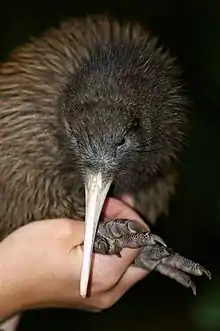
In June 2006, the Trust began reintroducing species, starting with a pair of critically endangered takahē. In April 2007, three species of endangered whitebait (kokopu or native trout) were reintroduced. In May, kākā were put into a special enclosure to allow them to acclimatise before they were released; they quickly attracted wild companions. In November of that year, seven kākā were released from the aviary.
On 3 December 2007 the trust announced that they planned to reintroduce North Island robins, North Island kōkako, tuatara, popokatea (whiteheads) and hihi (stitchbirds) in 2008. March 2009 saw the release of 60 whiteheads (popokatea) and 59 hihi (stitchbirds).
Mammals
- New Zealand long-tailed bat (Chalinolobus tuberculatus)[7]
Birds
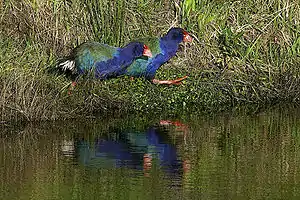
- Grey teal (Anas gracilis)
- Australasian shoveler (Anas rhynchotis)
- Grey duck (Anas superciliosa)
- New Zealand bellbird (korimako) (Anthornis melanura)
- North Island brown kiwi (kiwi) (Apteryx mantelli)
- Australasian bittern (Botaurus poiciloptilus)
- Shining cuckoo (Chrysococcyx lucidas)
- Australasian harrier (Circus approximans)
- White-faced heron (Egretta novaehollandiae)
- New Zealand falcon (kārearea) (Falco novaeseelandiae)
- Grey warbler (riroriro) (Gerygone igata)
- New Zealand kingfisher (Halcyon sancta)
- Wood pigeon (kererū) (Hemiphaga novaeseelandiae)
- Welcome swallow (Hirundo neoxena)
- Morepork (Ninox novaeseelandiae)
- Stitchbird (hihi) (Notiomystis cincta)
- North Island tomtit (Miromiro) (Petroica macrocephala toitoi)
- Whitehead (pōpokotea) (Mohoua albicilla)
- Black shag (Phalacrocorax carbo)
- Little pied cormorant (Phalacrocorax melanoleucos)
- New Zealand dabchick (Poliocephalus rufopectus)
- Takahē (Porphyrio hochstetteri)
- Pukeko (Porphyrio porphyrio)
- North Island fantail (Piwakawaka) (Rhipidura fulginosa placabilis)
- Paradise shelduck (Tadorna variegata)
- Silvereye (Zosterops lateralis)
- Tui (Prosthemadera novaeseelandiae)
- Kākā, (Nestor meridionalis)
Amphibians
- Hochstetter's frog (Leiopelma hochstetteri)[8]
Reptiles
- Copper skink (Cyclodina aenea)
- Forest gecko (Hoplodactylus granulatus)
- Pacific gecko (Hoplodactylus pacifica)
- Auckland green gecko (Naultinus elegans elegans)
- Duvaucel's gecko (Hoplodactylus duvaucelli)
Fish
- New Zealand longfin eel (Anguilla dieffenbachii)
- Giant kokopu, (Galaxias argenteus)[9]
- Banded kokopu, (Galaxias fasciatus)[9]
- Shortjaw kokopu, (Galaxias postvectis)[9]
Community
Maungatautari | |
|---|---|
Village | |
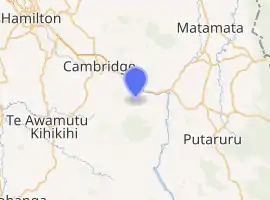
| |
| Coordinates: 37°58′S 175°34′E | |
| Country | New Zealand |
| Region | Waikato Region |
| District | Waipa District |
| Population (2018 census) | |
| • Territorial | 822 |
| Time zone | UTC+12 (NZST) |
| • Summer (DST) | UTC+13 (NZDT) |
Demographics
| Year | Pop. | ±% p.a. |
|---|---|---|
| 2006 | 717 | — |
| 2013 | 750 | +0.64% |
| 2018 | 822 | +1.85% |
| Source: [10] | ||
The Maungatautari statistical area, which is 113 square kilometres, had a population of 822 at the 2018 New Zealand census, an increase of 72 people (9.6%) since the 2013 census, and an increase of 105 people (14.6%) since the 2006 census. There were 303 households. There were 414 males and 408 females, giving a sex ratio of 1.01 males per female. The median age was 39 years (compared with 37.4 years nationally), with 165 people (20.1%) aged under 15 years, 165 (20.1%) aged 15 to 29, 390 (47.4%) aged 30 to 64, and 102 (12.4%) aged 65 or older.
Ethnicities were 89.1% European/Pākehā, 12.0% Māori, 1.1% Pacific peoples, 3.3% Asian, and 1.5% other ethnicities (totals add to more than 100% since people could identify with multiple ethnicities).
The proportion of people born overseas was 18.6%, compared with 27.1% nationally.
Although some people objected to giving their religion, 54.4% had no religion, 36.5% were Christian, 0.4% were Hindu, 0.7% were Buddhist and 3.3% had other religions.
Of those at least 15 years old, 141 (21.5%) people had a bachelor or higher degree, and 87 (13.2%) people had no formal qualifications. The median income was $41,200, compared with $31,800 nationally. The employment status of those at least 15 was that 381 (58.0%) people were employed full-time, 96 (14.6%) were part-time, and 15 (2.3%) were unemployed.[10]
References
- "1000 Māori place names". New Zealand Ministry for Culture and Heritage. 6 August 2019.
- "Māori Maps". maorimaps.com. Te Potiki National Trust.
- "Te Kāhui Māngai directory". tkm.govt.nz. Te Puni Kōkiri.
- Neems, Jeff (22 April 2010). "Rare lizard killed in trap". Waikato Times. Retrieved 22 October 2011.
- http://www.maungatrust.org/Biodiversity_Mgt_Restoration.cfm
- "Sanctuary Mountain Maungatautari - Our Story".
- "Sanctuary Mountain Maungatautari Wildlife".
- "Sanctuary Mountain Maungatautari Wildlife".
- "Sanctuary Mountain Maungatautari Wildlife".
- "Statistical area 1 dataset for 2018 Census". Statistics New Zealand. March 2020. Maungatautari (184900). 2018 Census place summary: Maungatautari
- "Official School Website". horahoracambridge.school.nz.
- Education Counts: Horahora School
- "Education Review Office Report". ero.govt.nz. Education Review Office.
- "Horahora (Maungatautari no. 2) School : golden jubilee 1909-1959 / editor: L. H. Liddell (archive record)". National Library. Retrieved 8 November 2020.
- "Maungatautari School jubilee, 1903-1978 (archive record)". National Library. Retrieved 8 November 2020.
- Akuhata, Karla (2 March 2012). "Waikato classrooms sitting idle". Waikato Times.
